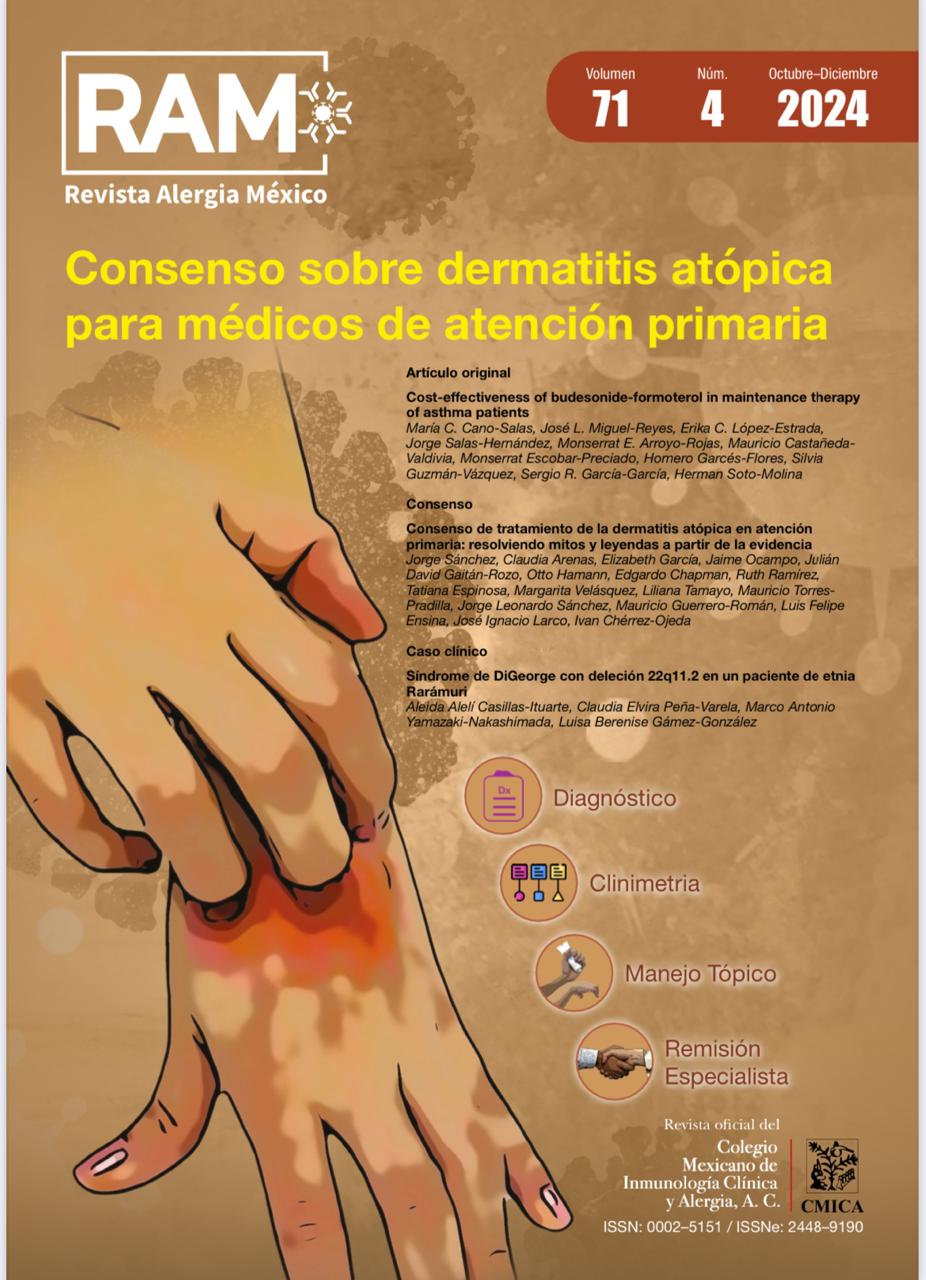Abstract
Objective: To develop a treatment algorithm for patients with penicillin allergy.
Methods: Retrospective study, carried out in adult patients with penicillin allergy, who were in group 3 or 4 of the established classification, and attended the outpatient clinic of the Department of Pulmonology and Allergy of the Central Hospital of the Social Security Institute, between January 2021 and December 2022. Each patient underwent an amoxicillin provocation test, after obtaining informed consent.
Results: 60 patients were registered, who were able to remove the penicillin allergy label and whose medical history was corrected, with financial benefits for the patient and the health service of Paraguay.
Conclusion: Penicillin allergy labels can lead to irrational prescription of antibiotics, prolonged hospital stays, and increased need for consultation. Risk stratification, based on historical characteristics alone, is capable of safely identifying ideal patients for direct challenge testing. This study demonstrates the feasibility of the first penicillin delabeling program applicable in an outpatient setting, which can be performed even outside of hospital allergy services.
Keywords: Allergy; Penicillin allergy; Amoxicillin; Paraguay; Risk stratifications; Feasibility; Antibiotic prescription.
References
Yilmaz R, Yuksekbas O, Erkol Z, Bulut ER, et al. Postmortem findings after anaphylactic reactions to drugs in Turkey. Am J Forensic Med Pathol 2009; 30: 346-349.
Jerschow E, Lin RY, Scaperotti MM, McGinn AP. Fatal anaphylaxis in the United States, 1999-2010: temporal patterns and demographic associations. J Allergy Clin Immunol 2014; 134: 1318-1328.
Albin S, Agarwal S. Prevalence and characteristics of reported penicillin allergy in an urban outpatient adult population. Allergy Asthma Proc 2014; 35: 489-494.
Picard M, Bégin P, Bouchard H, et al. Treatment of patients with a history of penicillin allergy in a large tertiary-care academic hospital. J Allergy Clin Immunol Pract 2013; 1: 252-257.
Powell N, West R, Sandoe JAT. The impact of penicillin allergy de-labelling on the WHO AWaRe antibiotic categories: a retrospective cohort study. J Hosp Infect 2021; 115: 10-16.
Baxter M. Bethune C. Powell R. Morgan M. Point prevalence of penicillin allergy in hospital in patients. J Hosp Infect 2020; 106: 65-70.
Steenvoorden L. Bjoernestad E.O. Kvesetmoen T.-A. Gulsvik A.K. De-labelling penicillin allergy in acutely hospitalized patients: a pilot study. BMC Infect Dis 2021; 21: 1083.
Macy E, Ngor EW. Safely diagnosing clinically significant penicillin allergy using only penicilloyl-poly-lysine, penicillin, and oral amoxicillin. J Allergy Clin Immunol Pract 2013; 1: 258-263.
Harandian F, Pham D, Ben-Shoshan M. Positive penicillin allergy testing results: a systematic review and meta-analysis of papers published from 2010 through 2015. Postgrad Med 2016; 128: 557-562.
Solensky R, Earl HS, Gruchalla RS. Clinical approach to penicillin-allergic patients: a survey. Ann Allergy Asthma Immunol 2000; 84: 329-333.
Hersh AL, Shapiro DJ, Zhang M, Madaras-Kelly K. Contribution of penicillin allergy labels to second-line broad-spectrum antibiotic prescribing for pediatric respiratory tract infections.Infect Dis Ther 2020; 9: 677-681.
Wolfson A.R. Mancini C.M. Banerji A. et al. Penicillin allergy assessment in pregnancy: safety and impact on antibiotic use. J Allergy Clin Immunol Pract 2021; 9: 1338-1346.
Blumenthal KG, Ryan EE, Li Y, Lee H, Kuhlen JL, et al. The impact of a reported penicillin allergy on surgical site infection risk. Clin Infect Dis 2018; 66: 329-336.
Blumenthal KG, Lu N, Zhang Y, Li Y, et al. Risk of meticillin resistant and in patients with a documented penicillin allergy: population based matched cohort study. BMJ 2018; 361k2400.
Jeffres MN, Narayanan PP, Shuster JE, Schramm GE. Consequences of avoiding β-lactams in patients with β-lactam allergies. J Allergy Clin Immunol 2016; 137: 1148-1153.
Kaminsky LW, Dalessio S, Al-Shaikhly T, Al-Sadi R. Penicillin allergy label increases risk of worse clinical outcomes in COVID-19. J Allergy Clin Immunol Pract 2021; 9: 3629-3637.
Sacco KA, Bates A, Brigham TJ, Imam JS, Burton MC. Clinical outcomes following inpatient penicillin allergy testing: a systematic review and meta-analysis. Allergy 2017; 72: 1288-1296.
Stone CA, Trubiano J, Coleman DT, Rukasin CRF, Phillips EJ. The challenge of de-labeling penicillin allergy. Allergy 2020; 75: 273-288.
Torres MJ, Adkinson NF, Caubet JC, et al. Controversies in drug allergy: beta-lactam hypersensitivity testing. J Allergy Clin Immunol Pract 2019; 7: 40-45.
Ortega-Cistneros M, et al. Alergia a penicilina. Art Rev. Rev Alergia Méx 2022; 69 (Supl l); 81-93.
Warner JO, Kaliner MA, Crisci CD, Del Giacco S, et al. Allergy practice worldwide: a report by the World Allergy Organization Specialty and Training Council. Allergy Clin Immunol Int–World Allergy Org Journal 2006; 18: 4-10; and Int Arch Allergy Immunol 2006; 139(2): 166-74.
Powell N, Honeyford K, Sandoe J. Impact of penicillin allergy records on antibiotic costs and length of hospital stay: a single-centre observational retrospective cohort. J Hosp Infect 2020; 106: 35-42.
Trubiano JA, Vogrin S, ChuaKYL, et al. Developmentandvalidationofa penicillin allergy clinical decision rule. JAMA Intern Med. 2020; 180 (5): 745-752. doi: 10.1001/jamainternmed.2020.0403

This work is licensed under a Creative Commons Attribution-NonCommercial 4.0 International License.
Copyright (c) 2024 Revista Alergia México

